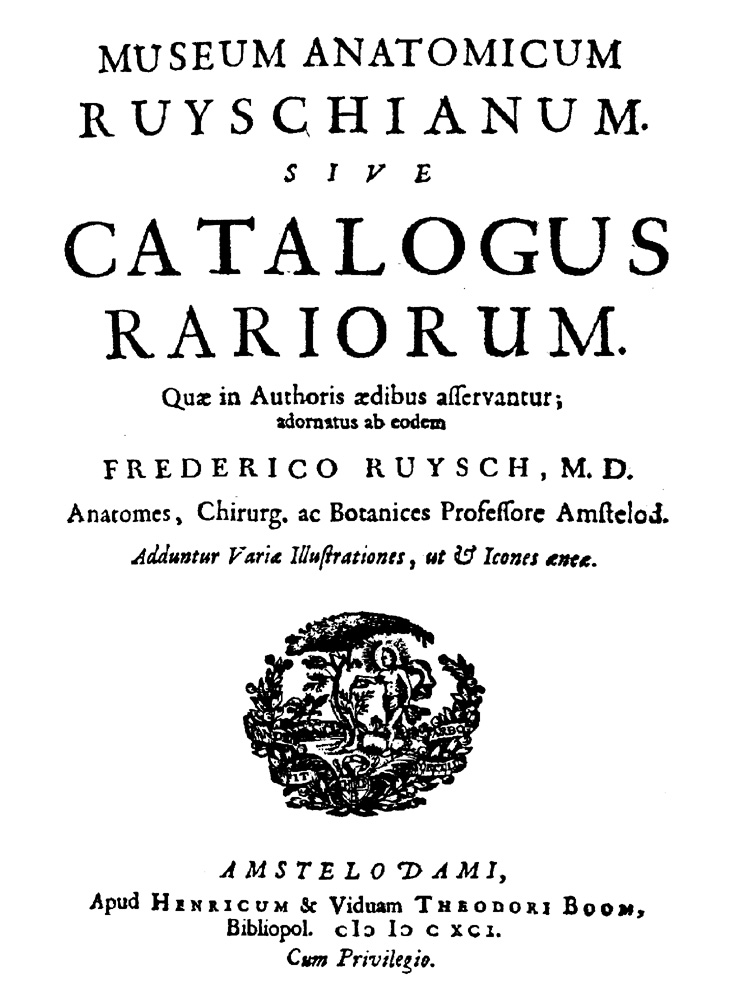RUYSCH, Frederick.
(1638 – 1731)
Ruysch was descended from an old and notable family, whose members were established in various cities. As a youth, he was apprenticed to an apothecary. In 1661, although not yet admitted to the apothecaries guild, he prepared prescriptions and opened his own shop in The Hague. However, the guild ordered him to suspend activity until he passed the required exam, which Ruysch did in the summer of 1661. In 1666, he was named praelector of anatomy for the surgeon's guild in Amsterdam. He held this post the remainder of his long life. Soon after he accepted the appointment, he relocated to Amsterdam, where in various rented houses, he displayed his ever growing collections of anatomical and natural history specimens.
Biographical references: Aa, Biographisch Woordenboek, 1852-78. • BAB: 588, 376-439 / 589, 1-46. • Biografisch Woordenboek Nederland: 3 ??, 1108-9 ??. • DSB: 12, 39-42 [by G.A. Lindeboom]. • Dutch Medical Biography. • Fontenelle, B., "Éloge de M. Ruysch", in: Histoire de l'Académie royale des sciences pour l'anné 1731 avec les mémoires de mathématique et physique pour la même année, tirés registres de cette Académie. Paris, 1731. • Hazen, N.T., "Johnson's life of Frederic Ruysch", Bulletin of the History of Medicine, 7, (1939), 324. • Hirsch, Biographisches Lexikon, 1884-8: 4, 934. • Jöcher, Gelehrten-Lexikon, 1750-51. • Kobus, Biographisch Woordenboek, 1886. • NNBW. • Scheltema, P., Het leven van Frederik Ruysch. M.D. Dissertation, University of Leiden, 1886. • Schreiber, J.F., Historia vitæ et meritorum Frederici Ruysch. Amsterdam, 1723. • WBI.

1. Latin, 1691 [Collection catalog].
Museum Anatomicum | Ruyschianum. | Sive | Catalogus | Rariorum. | Quæ in Authoris ædibus asservantur; | adornatus ab eodem | Frederico Ruysch, M.D. | Anatomes, Chirurg. ac Botanices Professore Amstelod. | Adduntur Variæ Illustrationes, ut & Icones æneæ. | [ornament] | Amstelodami, | Apud Henricum & Viduam Theodori Boom, | Bibliopol. cI{[Backwards c] I[Backwards c] c xci}. | Cum Privilegio.
2 parts in one volume. [Part 1] 4°: [16], 138 p. [Part 2] 4° [2], 120 p., 46 engraved plates (4 folding).
Very scarce. Published as the second part in Ruysch's Observationum Anatomico-Chirurgicarum Centuria. Accedit Catalogus Rariorum, quae in Museo Ruyschiano Asservantur (Amsterdam, 1691).Eimas 613: "Ruysch presents the results of one hundred studies and illustrates many of them with excellent engravings, many of which are undoubtedly enhanced by his injection techniques. Also bound with this work (= Tl. II) is his 'Museum anatomicum Ruyschianum', a catalogue of the specimens in his museum, which was purchased and moved to Russia by Peter the Great in 1717." Figures 32-33 left out in numbering of illustrations.
Bibliographical references: Eales: 1, 649. • NLM 17th Century Books (Krivatsy): no. 10071. • Sallander, Bibliotheca Walleriana, 1955: no. 8337. • Wellcome Catalog (Books): 4, 597.

2. Latin, 1731 [Sale catalog].
Catalogus | Musæi | Ruyschiani, | sive | Permagnæ, Elegantissimæ, Nitidissimæ, | Incomparabilis, & verè Regiæ | Collectionis; | Præparatorum Anatomicorum, variorum Animalium, | Plantarum, aliarumque Rerum Naturalium, | quas maximo labore, studio, sumtum, singulari | artificio & industriâ collegit, præparavit, & | conservavit, dum viveret, Vir Summus & | Celeberrimus | Fredericus Ruyschius, | [...3 lines of titles and memberships...] | Quæ publicè distrahentur in ædibus defuncti, primo & | sequentibus diebus mensis Augusti, Anni 1731, | horâ nonâ matutinâ, & secundâ Pomeridianâ. | [ornament] | Amstelædami, | Apud Janssonio-Waesbergios.
8°: [2], [1]-94 p.
Very rare. Auction catalogue of the second, and larger, collection of anatomical and natural history specimens formed by Ruysch. Resident in Amsterdam, Ruysch's collection was famous throughout Europe, and visited by many persons of every description. Generals, ambassadors, princes, and even kings were happy in the opportunity of examining it. In 1698, when Peter the Great visited Holland, he often dined with Ruysch so that he might have an opportunity of examining the cabinet. Ruysch liked his cabinet to be displayed in dramatic ways. "He prepared a corpse of a child as if it were alive so that Peter the Great was inclined to kiss it. A hydrocephalic child was prepared, seated on a cushion and with a placneta in its hands.' (DSB)
In 1715, Ruysch announced his intention to sell the collection, but no buyers presented themselves. In 1717, on a return visit to Holland, Peter the Great bought it for 30,000 guilders. It was carefully packed and transported by boat to Russia, becoming part of the Royal collections. Immediately after the sale, Ruysch, age 79, began a new collection. After Ruysch's death in 1731, at age 96, the new collection was sold at auction. A large number of items were acquired for 20,000 florins by the King of Poland, John Sobieski, who entrusted their preservation to the University of Wittenberg. (Muray) The catalog of this sale shows that Ruysch's second collection was substantially larger than his first; it describes 1189 anatomical specimens, 27 lots of exotic plants, and a few lots of mineralogical interest in the natural history section. The collection sold to Peter the Great in 1717 contained only 935 items.
Bibliographical references: BL [1044.c.4.(2.)]. • DSB: 12, 39-41. • Gatterer, Mineralogischen Literatur, 1798-9: 1, 276. • Murray, Museums, 1904: 1, 116-7, 182 & 209. • Wilson, History of Mineral Collecting, 1994: 222-3.
.